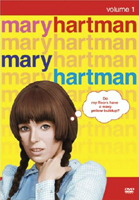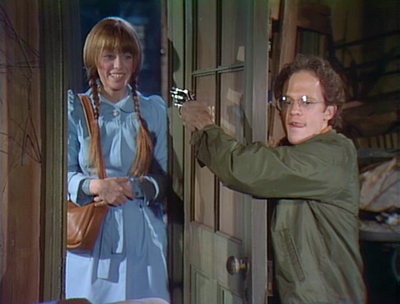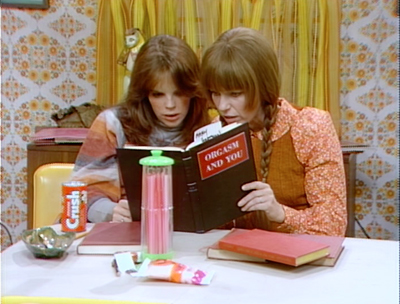 BUY ME AT AMAZON: CLICK HERE!
BUY ME AT AMAZON: CLICK HERE!
STUDIO: Sony
MSRP: $29.95
RATED: Not Rated
RUNNING TIME: 564 min
SPECIAL FEATURES: Previews for other shows.
The Pitch
“These people, they turn out about a million cans a week. Who am I supposed to listen to– you?”
The Humans
Louise Lasser (Bananas), Greg Mullavey, Mary Kay Place (The Big Chill), Graham Jarvis (Cold Turkey), Debralee Scott, Dody Goodman (Splash)
The Nutshell
Mary Hartman (Lasser) is a homemaker in Fernwood, Ohio. She cleans house, watches her soaps, and has a Schlitz ready for her husband Tom (Mullavey) when he comes home from work. Her life is unexamined, her duties mundane, her pleasures simple.
Then Tom stops wanting to have sex. And her daughter stops listening to her. Her best friend Loretta (Place) is taking off for Nashville in pursuit of a singing career. Her grandfather is discovered to be none other than the Fernwood Flasher. Most disappointingly, her new floor wax fails to deliver the glowing shine promised by its label.
Oh, and somebody just murdered the family on the next block. Shot them dead, along with their goats and chickens. Who shoots goats and chickens? That’s just wrong! What’s an ordinary housewife to do?

In hot weather, poor Mary’s brain ran less efficiently.
The disruption of Mary’s daily routine frees her to begin to recognize the ways in which other people take her for granted. As the story progresses, she emerges, unwittingly, as the only self-aware person in town. She can’t win, of course, or she wouldn’t be a soap-opera heroine herself.
The Lowdown
It would be easy for this show to function as a simple spoof of cheap melodrama, but it has bigger plans. Mary Hartman, Mary Hartman’s strategy is almost too subtle: the show walks, talks and looks like an ordinary soap opera. In its original broadcast, it even aired five days a week like a regular afternoon serial. There’s no laugh track to signal the jokes— instead, the absurdities and hypocrisies are allowed to slowly sink in. Long, wordless close-ups occur frequently, and Lasser deploys a wide variety of blank, bewildered stares.
Even more remarkably, she does so without condescending to the character. Mary may look like a cartoon, with her droopy pigtails that seem to be forever pulling her down into the ground, but she has real feelings, and we the audience are the only people that know it. When, about twenty episodes in, she pours her heart out to insecure, infantile, cheating Tom and they finally make love, the emotion is authentic. The irony is that Tom merely sees his uppity wife rendered weak and vulnerable… and prefers her that way.

The quintessential last farewell of the 30-year-old basement-dweller.
Like the Norman Lear productions before it such as All in the Family, Maude, and The Jeffersons, Mary Hartman… takes a standard TV format and sets it against changing times. The focus here is the Silent Generation—those folks born just a little too early to be teenagers in the Sixties, or to experience the Sexual Revolution and the Counter-Culture Movement firsthand. They know what went on: it was on television, after all, and they were the first kids to come of age with an idiot box in the house.
The show’s exploration of the effects of TV on society is fascinating. All the characters appear, on some level, to understand that they’re on TV. Or maybe they’ve just become conditioned to behave like the people they see on TV. Brand-name products are prominently displayed on tabletops or held at chest-level so as to appear in the frame; Mary’s ‘sensitive’ admirer is just a guy who has learned smoother pick-up lines; would-be country star Loretta works harder at acting famous than at singing well. Most pointedly, all authority figures– politicians, policemen and clergy—are empty suits, long on self-interest and short on responsibility. Where’s that kind of satire today?

The look of hunger…
The Package
Volume One comprises episodes 1 through 25, spread over three discs– the first five weeks of the first year. It’s as good a place as any to draw the line for a box set, and concludes with a fine cliffhanger, but at this rate it’ll take twelve more volumes to release the complete series.
The picture looks about as good as 1970s video is ever going to look. Glitches are non-existent. The show was shot on very tight schedules (again, like a real soap opera), and occasionally microphones are visible and camera equipment audible, but that adds to the charm, and the meta.
There are no supplements, which is a shame, especially considering that most of the cast reunited in 2000 for a panel discussion at the Museum of Television and Radio. Mary Hartman, Mary Hartman was– and remains–daring, innovative television in a plain wrapper.

And me!